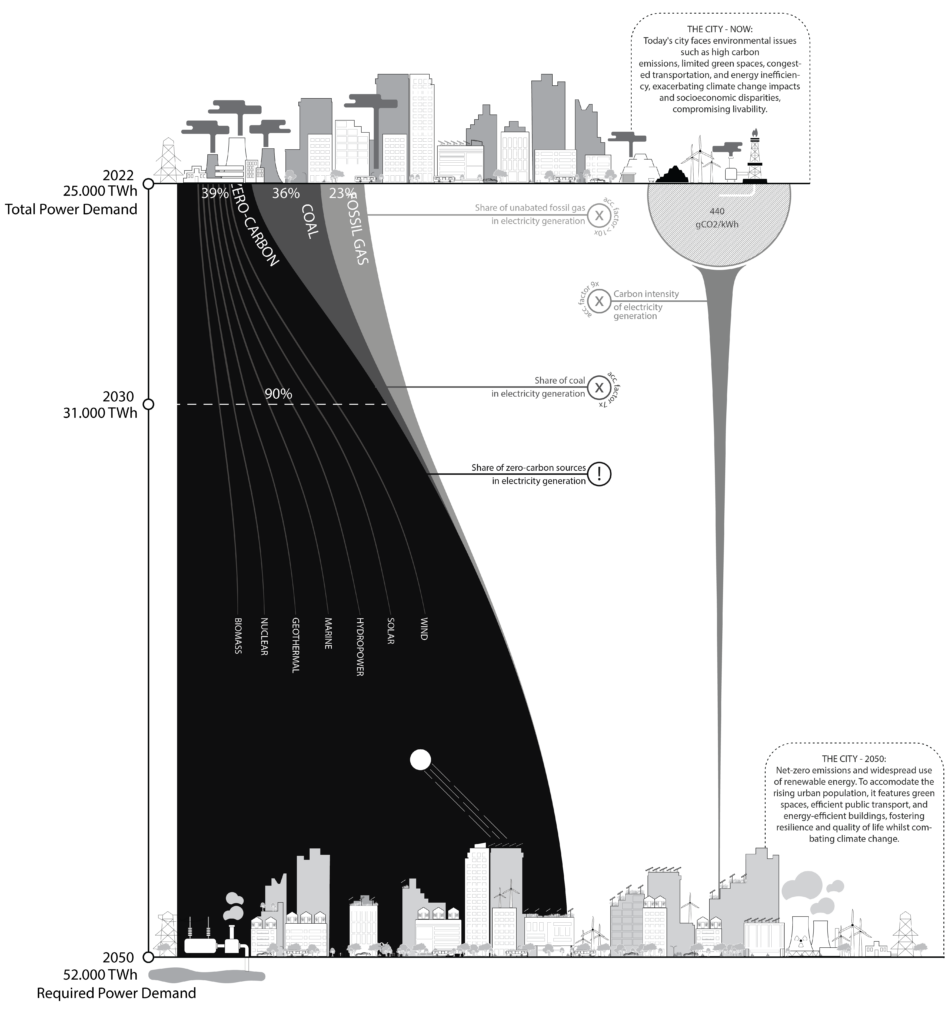This blog summarizes section 2 (Power) of the book State of Climate Action 2023 with an illustration.
The graphic illustrates the energy transitions required to achieve the immense task of preventing global warming beyond the 1.5-degree mark as called for in the Paris Agreement. We have represented the imaginary city of 2050, having reached the 40,000 terawatt-hours in 2030 and achieved the NZE in 2050. Thereby, attempting to keep the global temperature rise below 1.5 degrees in order to avoid the doomsday scenario.

The process of achieving NZE carbon emissions includes the following indicators:
Power Indicators:
- The share of zero-carbon sources in electricity generation reaches 88–91 percent by 2030, 98–99 percent by 2040, and 99–100 percent by 2050.
- The share of coal in energy generation falls to 4 per cent by 2030, 0-1 percent by 2040 and 0 percent by 2050.
- The share of unabated fossil gas in electricity generation falls to 5–7 percent by 2030, 1 percent by 2040, and goes down to 0 percent by 2050.
- The carbon intensity of electricity generation globally falls to 48–80 grams of carbon dioxide per kilowatt-hour (gCO2/kWh) by 2030, 2–6 gCO2/kWh by 2040, and below zero by 2050.
Hence, not only do we need to make the shift to renewable energy sources (referred to in the text as non-zero sources) we also need to slowly phase out the use of fossil gas and coal power. This phase out needs to happen gradually while keeping the varying speeds of development and production in certain developing nations that cannot immediately make the transition to renewable energy sources in mind. Wealthier countries that have historically generated the most amount of emissions also now have the greatest capacity to cut them sharply. These countries also have the responsibility to mobilize significantly and the climate finance to support other countries’ transitions in order to reduce misaligned finance flows (e.g. Financing for fossil fuel projects abroad and fossil fuel subsidies)
What the trends lead us to believe is that the activities that involve innovation and development of new technologies seem to be on track. It is the phasing out of existing fossil fuel based power plants and our reliance on non-renewable sources of energy that’s proving to be a challenge. We also do not have reliable systems of predicting the logarithmic growth patterns of renewable sources of energy, since not only are they all at varying stages of maturity and development, but also rely on the phasing out of fossil-based sources of energy. Thus resulting in a sharp increase in demand and sharp increase in supply of renewable energy resources.
Another factor that is important to note is that, no energy source is zero-carbon. There has been no mention of the embodied energy values of the various renewable energy sources indicating the need to apply the same principles of building sustainably and sequestering carbon in these production setups. The systems of transport and storage of energy also need to be refined as well as the processes of site selection and scalability.
In conclusion, achieving the envisioned energy transition demands concerted global efforts, strategic planning,and progressive innovation to navigate the complexities and challenges inherent in decarbonizing power generation while securing a sustainable future for urban environments.
Some important terms:
1. NZE: Net-zero Emissions
2. Unabated fossil gas: fossil fuel combustion without the application of carbon capture and storage (CCS) technology.
3. Zero carbon sources: include solar, wind, hydropower, geothermal, nuclear, marine, and biomass technologies.

